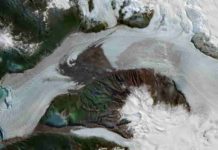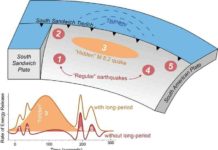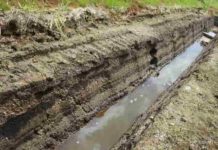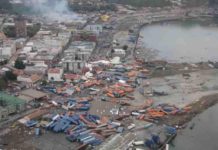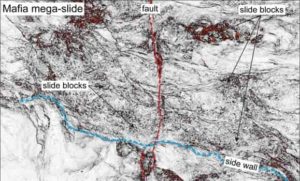
A recent study, published in Nature Communications, discovered that earthquakes and continental movements triggered massive underwater landslides tens of millions of years ago off the coast of East Africa—findings that could help assess the future risk of tsunamis to the increasingly populated coastline in the region.
Led by Vittorio Maselli, Canada Research Chair in Coastal Zone Processes and an assistant professor in the Faculty of Science’s Department of Earth and Environmental Sciences, the study is the first to link large-scale submarine mass movements of sediment and rock in the margin slope of the western Indian Ocean with continental rifting and, thus, the formation of a new plate boundary.
With help from industry, Dr. Maselli and his team used seismic data to explore the continental margin of Tanzania in the western Indian Ocean and quantify the distribution of submarine landslide deposits at the sea floor and in the sediments beneath. The authors were able to identify catastrophic mass wastings as old as 40 million years.
“We discovered that hundreds of kilometre wide underwater landslides occurred during a specific time window along the Tanzania margin,” says Dr. Maselli. “One of these landslides, which we named the Mafia mega-slide, is one of the biggest landslides ever discovered on Earth. We dated the Mafia mega-slide to about 20 million years ago by using data from two exploration wells.”
“Still tectonically very active”
The name Mafia mega-slide derives from the island located just landward of it. Mafia Island is one of three major Islands in Tanzania, together with Pemba and Zanzibar. The mega-slide covers 11,600 km2, the size of more than 2 million hockey rinks.
Dr. Maselli and his team then interpreted the Mafia mega-slide and the other landslides occurring at the same time as a consequence of the East African Rift System (EARS), hypothesizing that plateau uplift and rifting in East Africa can trigger potentially tsunamigenic landslides likely through earthquake activity and enhanced sediment supply.
“The study area is still tectonically very active, as demonstrated by the earthquakes recorded in the western Indian Ocean and in the continent over the last few decades. We also found many, but much smaller, submarine landslide deposits and fault escarpments of the modern sea floor.”
Just the beginning
This information indicates that underwater sediment failures, likely of a smaller extent if compared with the Mafia mega-slide, can still occur today. But many questions remain unanswered: How often they can occur? What is their size? What is the trigger mechanism?
By replying to these questions, Dr. Maselli says, we will help evaluating the risks associated with underwater landslides along the margin of Tanzania and their potential in generating tsunamis. Indeed, the sudden movement of sediment underwater can generate catastrophic tsunami waves, and understanding if, or how often, they may occur, is a critical information in this region due to the rapid population growth along the coastline.
“Our study is just the beginning, and we plan to further investigate the data available to understand the impact of submarine landslides on the evolution of the margin,” he says. “We will also use numerical models to simulate the generation and propagation of landslide-induced tsunami waves and identify which areas along the coast can be more at risk.”
Reference:
Vittorio Maselli et al. Large-scale mass wasting in the western Indian Ocean constrains onset of East African rifting, Nature Communications (2020). DOI: 10.1038/s41467-020-17267-5
Note: The above post is reprinted from materials provided by Dalhousie University.







